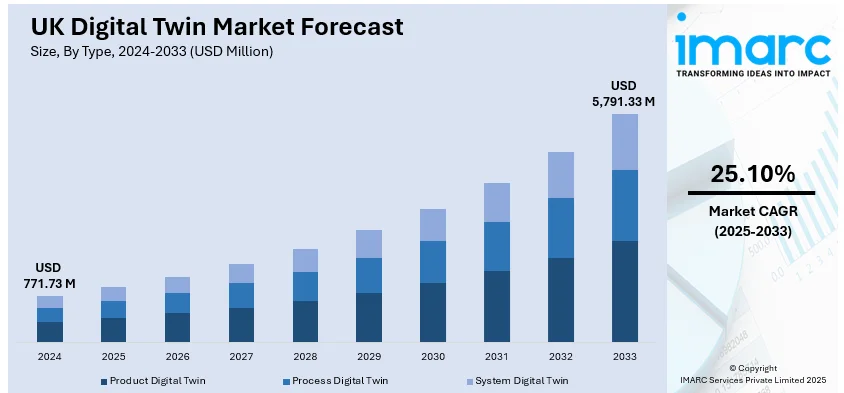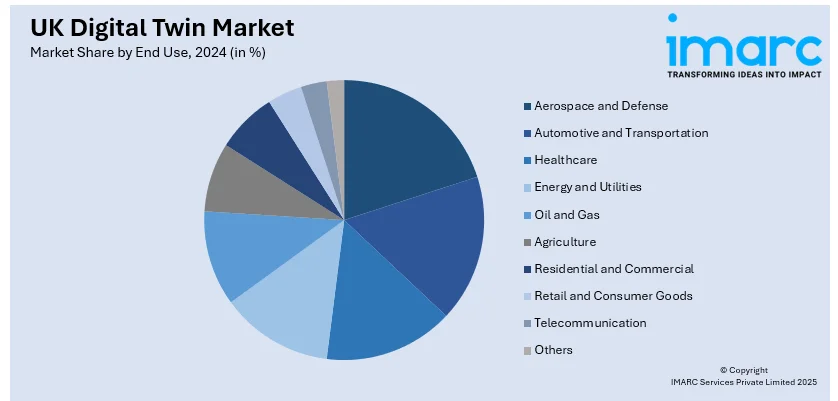
UK Digital Twin Market Size, Share, Trends and Forecast by Type, Technology, End Use, and Region, 2025-2033
UK Digital Twin Market Overview:
The UK digital twin market size reached USD 771.73 Million in 2024. Looking forward, IMARC Group expects the market to reach USD 5,791.33 Million by 2033, exhibiting a growth rate (CAGR) of 25.10% during 2025-2033. The market is experiencing significant growth mainly driven by the widespread product adoption across industries, such as manufacturing, construction, and healthcare. The increasing integration of IoT, AI, and data analytics, are further enabling organizations to optimize operations, reduce costs, and enhance predictive maintenance through real-time simulations, which, in turn, is facilitating UK digital twin market growth.
|
Report Attribute
|
Key Statistics
|
|---|---|
|
Base Year
|
2024 |
|
Forecast Years
|
2025-2033
|
|
Historical Years
|
2019-2024
|
| Market Size in 2024 | USD 771.73 Million |
| Market Forecast in 2033 | USD 5,791.33 Million |
| Market Growth Rate 2025-2033 | 25.10% |
UK Digital Twin Market Trends:
Integration of IoT and AI
The integration of IoT and AI with digital twins is revolutionizing industries by enabling more intelligent and efficient systems. IoT devices continuously collect real-time data from physical assets, feeding this information into digital twins for accurate simulations and monitoring. When combined with AI, digital twins can analyze vast datasets, predicting potential issues before they occur and optimizing operational processes. This convergence enhances decision-making capabilities by offering real-time insights, improving performance, and reducing downtime. Therefore, this is significantly expanding the UK digital twin market share. In industries including manufacturing, smart cities, and healthcare, AI-driven digital twins facilitate automation, enabling systems to self-regulate based on predictive analysis. This integration is proving critical in areas such as predictive maintenance, energy optimization, and adaptive manufacturing, thereby driving efficiency and cost savings across sectors. For instance, in June 2023, a new research project funded by a £2.5 Million grant from the UK Research and Innovation was launched, which aims to develop a self-learning digital twin of the UK. The goal is to use this digital twin to inform environmentally friendly land use. The project will utilize artificial intelligence and big data to reduce emissions from land use, with a particular focus on cattle and sheep farming as well as degraded peatlands. The team of researchers from leading universities will collaborate with industry leaders to create intelligent computer code aimed at helping the UK achieve its net zero target by 2050.

Rising Focus on Sustainability
Sustainability is one of the areas where organizations are slowly adopting digital twin technology since it leads to optimizing energy consumption, reducing carbon emissions, and minimizing waste for better sustainability. These virtual replicas of physical systems allow companies to simulate their operations, identify inefficiencies, and adjust to greener practices without disrupting existing processes. Digital twins enable U.K. business sectors such as manufacturing, transportation, and urban development to deliver on national sustainability goals. Digital twins help organizations achieve energy efficiency and environmental sustainability solutions that also feed into wider decarbonization activities by enabling better real-time monitoring and predictive maintenance. Thus, this is also creating a positive UK digital twin market outlook. For instance, in August 2024, the UK government and partners invested £46 Million in TransiT Hub to decarbonize transport. The hub, led by Heriot-Watt University and University of Glasgow, will pioneer the use of digital twins to rapidly analyze real-world data and test scenarios for decarbonizing road, rail, air, and maritime transport. Digital twins will simulate future transport systems, such as electric roads and alternative fuels, to identify the most energy-efficient pathway to achieve net-zero carbon emissions.
UK Digital Twin Market Segmentation:
IMARC Group provides an analysis of the key trends in each segment of the market, along with forecasts at the country level for 2025-2033. Our report has categorized the market based on type, technology, and end use.
Type Insights:
- Product Digital Twin
- Process Digital Twin
- System Digital Twin
The report has provided a detailed breakup and analysis of the market based on the type. This includes product digital twin, process digital twin, and system digital twin.
Technology Insights:
- IoT and IIoT
- Blockchain
- Artificial Intelligence and Machine Learning
- Augmented Reality, Virtual Reality and Mixed Reality
- Big Data Analytics
- 5G
A detailed breakup and analysis of the market based on the technology have also been provided in the report. This includes IoT and IIoT, blockchain, artificial intelligence and machine learning, augmented reality, virtual reality and mixed reality, big data analytics, and 5G.
End Use Insights:

- Aerospace and Defense
- Automotive and Transportation
- Healthcare
- Energy and Utilities
- Oil and Gas
- Agriculture
- Residential and Commercial
- Retail and Consumer Goods
- Telecommunication
- Others
The report has provided a detailed breakup and analysis of the market based on the end use. This includes aerospace and defense, automotive and transportation, healthcare, energy and utilities, oil and gas, agriculture, residential and commercial, retail and consumer goods, telecommunication, and others.
Regional Insights:
- London
- South East
- North West
- East of England
- South West
- Scotland
- West Midlands
- Yorkshire and The Humber
- East Midlands
- Others
The report has also provided a comprehensive analysis of all the major regional markets, which include London, South East, North West, East of England, South West, Scotland, West Midlands, Yorkshire and The Humber, East Midlands, and others.
Competitive Landscape:
The market research report has also provided a comprehensive analysis of the competitive landscape. Competitive analysis such as market structure, key player positioning, top winning strategies, competitive dashboard, and company evaluation quadrant has been covered in the report. Also, detailed profiles of all major companies have been provided.
UK Digital Twin Market News:
- On June 2024, the UK's National Grid, ESO, partnered with the government to create digital twins for the energy industry. This collaboration aims to showcase digital twin development, share energy data, and establish policy requirements. The initiative will enhance ESO's Virtual Energy System Programme by focusing on technical design and interface identification. This partnership reflects the increasing global demand for digital twin technology in critical infrastructure.
- On May 2024 Belfast Region City Deal and Innovate UK announced £37.6 Million investment into the UK Digital Twin Centre to revolutionize industries in the UK. Digital twins will be one of the five priority areas of the new Centre, backed by key industry partners, with the aim of accelerating the uptake of virtual replicas of physical objects or systems. The investment, with £15m coming from the Belfast Region City Deal, is projected to create 230 new manufacturing jobs and contribute £61 Million to the Northern Ireland economy by 2033.
UK Digital Twin Market Report Coverage:
| Report Features | Details |
|---|---|
| Base Year of the Analysis | 2024 |
| Historical Period | 2019-2024 |
| Forecast Period | 2025-2033 |
| Units | Million USD |
| Scope of the Report |
Exploration of Historical Trends, Market Outlook, Industry Catalysts, Challenges, Segment-Wise Historical, Future Market Assessment:
|
| Types Covered | Product Digital Twin, Process Digital Twin, System Digital Twin |
| Technologies Covered | IoT and IIoT, Blockchain, Artificial Intelligence, Machine Learning, Augmented Reality, Virtual Reality, Mixed Reality, Big Data Analytics, 5G |
| End Uses Covered | Aerospace, Defense, Automotive, Transportation, Healthcare, Energy, Utilities, Oil, Gas, Agriculture, Residential, Commercial, Retail, Consumer Goods, Telecommunication, Others |
| Regions Covered | London, South East, North West, East of England, South West, Scotland, West Midlands, Yorkshire, The Humber, East Midlands, Others |
| Customization Scope | 10% Free Customization |
| Post-Sale Analyst Support | 10-12 Weeks |
| Delivery Format | PDF, Excel through Email (We can also provide the editable version of the report in PPT/Word format on special request) |
Key Questions Answered in This Report:
- How has the UK digital twin market performed so far and how will it perform in the coming years?
- What is the breakup of the UK digital twin market on the basis of type?
- What is the breakup of the UK digital twin market on the basis of technology?
- What is the breakup of the UK digital twin market on the basis of end use?
- What is the breakup of the UK digital twin market on the basis of region?
- What are the various stages in the value chain of the UK digital twin market?
- What are the key driving factors and challenges in the UK digital twin market?
- What is the structure of the UK digital twin market and who are the key players?
- What is the degree of competition in the UK digital twin market?
Key Benefits for Stakeholders:
- IMARC’s industry report offers a comprehensive quantitative analysis of various market segments, historical and current market trends, market forecasts, and dynamics of the UK digital twin market from 2019-2033.
- The research report provides the latest information on the market drivers, challenges, and opportunities in the UK digital twin market.
- Porter's five forces analysis assist stakeholders in assessing the impact of new entrants, competitive rivalry, supplier power, buyer power, and the threat of substitution. It helps stakeholders to analyze the level of competition within the UK digital twin industry and its attractiveness.
- Competitive landscape allows stakeholders to understand their competitive environment and provides an insight into the current positions of key players in the market.
Need more help?
- Speak to our experienced analysts for insights on the current market scenarios.
- Include additional segments and countries to customize the report as per your requirement.
- Gain an unparalleled competitive advantage in your domain by understanding how to utilize the report and positively impacting your operations and revenue.
- For further assistance, please connect with our analysts.
 Inquire Before Buying
Inquire Before Buying
 Speak to an Analyst
Speak to an Analyst
 Request Brochure
Request Brochure
 Request Customization
Request Customization




.webp)




.webp)












